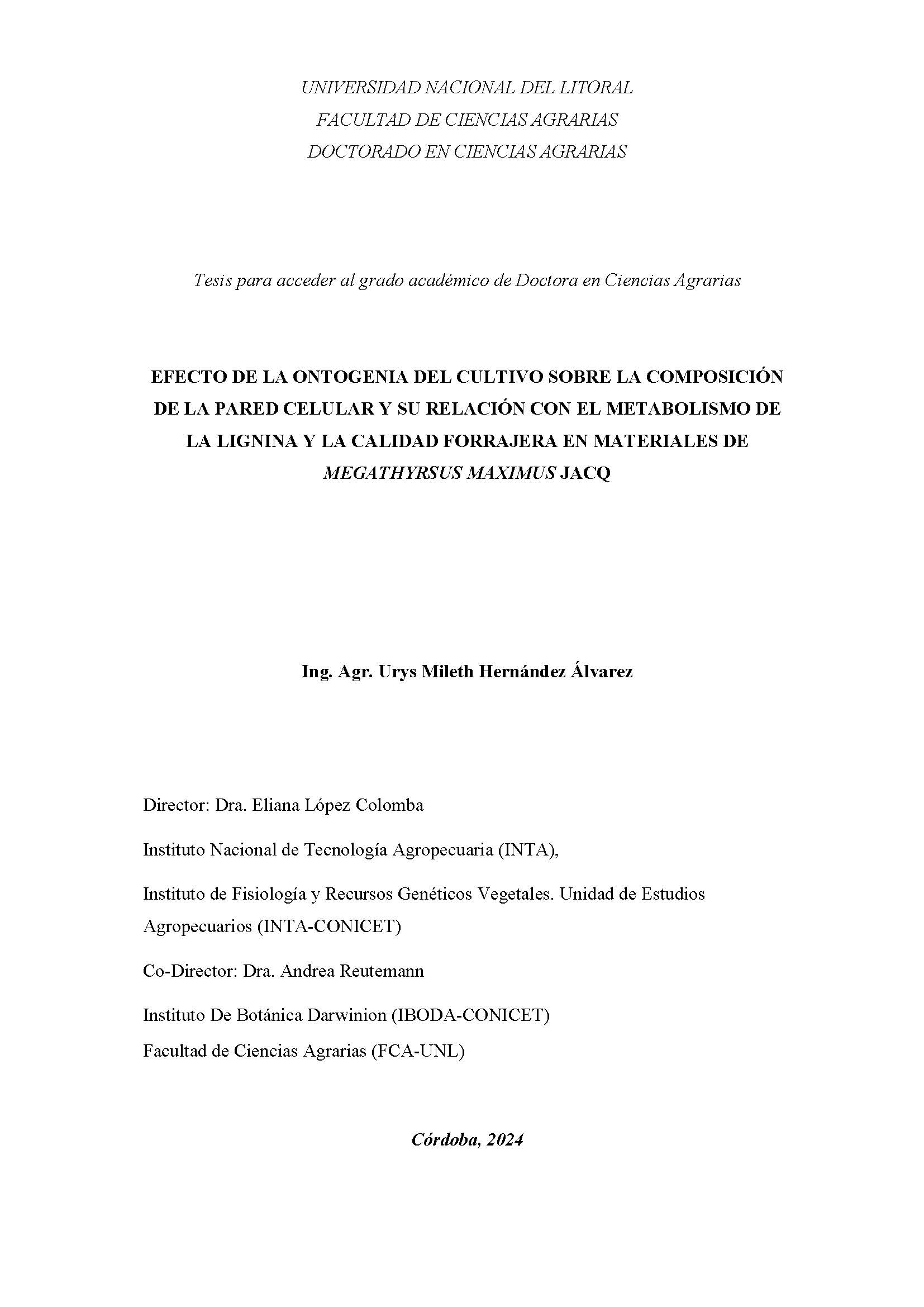Ver ítem
- xmlui.general.dspace_homeCentros e Institutos de InvestigaciónCIAP. Centro de Investigaciones AgropecuariasInstituto de Fisiología y Recursos Genéticos VegetalesTesisxmlui.ArtifactBrowser.ItemViewer.trail
- Inicio
- Centros e Institutos de Investigación
- CIAP. Centro de Investigaciones Agropecuarias
- Instituto de Fisiología y Recursos Genéticos Vegetales
- Tesis
- Ver ítem
Efecto de la ontogenia del cultivo sobre la composición de la pared celular y su relación con el metabolismo de la lignina y la calidad forrajera en materiales de Megathyrsus Maximus Jacq
Resumen
Megathyrsus maximus es una pastura forrajera originaria de África, ampliamente cultivada en regiones tropicales y subtropicales del mundo y en Argentina se utiliza en sistemas ganaderos pastoriles. Este estudio tuvo como objetivos evaluar la existencia de variabilidad genética entre diferentes genotipos de M. maximus (Gatton Panic, Green Panic, Vencedor, Penquero y Mutale) a través de marcadores intermicrosatelites (ISSR) e inferir su nivel de ploidía,
[ver mas...]
Megathyrsus maximus es una pastura forrajera originaria de África, ampliamente cultivada en regiones tropicales y subtropicales del mundo y en Argentina se utiliza en sistemas ganaderos pastoriles. Este estudio tuvo como objetivos evaluar la existencia de variabilidad genética entre diferentes genotipos de M. maximus (Gatton Panic, Green Panic, Vencedor, Penquero y Mutale) a través de marcadores intermicrosatelites (ISSR) e inferir su nivel de ploidía, determinar el efecto de la madurez en características morfo-agronómicas, de composición química, histológicas y de expresión de genes asociados al metabolismo de la lignina, y correlacionar la anatomía de láminas y tallos con su valor nutritivo. Los ensayos se establecieron en dos sitios experimentales (Campus UCC e INTA Manfredi), en un diseño de bloques al azar con tres repeticiones. Se realizaron tres cortes cada 35 días en forma mecánica. El análisis por ISSR confirmó que los cinco genotipos eran distantes genéticamente y por otra parte presentaron igual nivel de ploidía. A nivel de láminas, la proporción de esclerénquima aumentó a medida que se alcanzó la madurez, lo que no se correspondió con la acumulación de Lignina Detergente Ácida (LDA), que fue diferente entre genotipos y permaneció sin cambios con el avance de la madurez en Gatton Panic, Green Panic y Mutale. Hubo asociación positiva entre los genes de la biosíntesis de la lignina, O-metiltransferasa del ácido cafeico, cinamoil CoA reductasa y cafeoil-CoA O-metiltransferasa, que habían incrementado su expresión del primer al tercer corte, con las variables LDA y Fibra Detergente Neutra (FDN) en torno al genotipo Vencedor para el tercer corte. En tallos, hubo asociación positiva entre FDN y FDA con la expresión de genes de la biosíntesis de la lignina. El uso de marcadores ISSR logró identificar variabilidad genética y el estudio por citometría de flujo permitió inferir el nivel de ploidía de los cinco genotipos. La madurez tuvo efecto negativo en la calidad del forraje de láminas y tallos y mayormente en el genotipo Vencedor.
[Cerrar]
Megathyrsus maximus is a forage native to Africa, widely cultivated in tropical and subtropical regions the world, it is used in pastoral livestock systems in Argentina. The aim of this study was to evaluate the existence of genetic variability between different genotypes of M. maximus (Gatton Panic, Green Panic, Vencedor, Penquero and Mutale) through intermicrosatellite molecular markers (ISSR) and infer its level of ploidy, to determine the effect of
[ver mas...]
Megathyrsus maximus is a forage native to Africa, widely cultivated in tropical and subtropical regions the world, it is used in pastoral livestock systems in Argentina. The aim of this study was to evaluate the existence of genetic variability between different genotypes of M. maximus (Gatton Panic, Green Panic, Vencedor, Penquero and Mutale) through intermicrosatellite molecular markers (ISSR) and infer its level of ploidy, to determine the effect of plant maturity on morphoagronomic traits, chemical composition, histological characteristics and the expression of genes associated with lignin metabolism and to correlate the anatomy of leaf blades and stems with their nutritional value. The assays were carried out in two different experimental sites (Campus UCC and INTA Manfredi), in a randomized block design with three replications. The cuts were made three times every 35 days by cutting the plots mechanically. The ISSR analysis confirmed that the genotypes evaluated in this study were genetically distant and on the other hand presented the same level of ploidy. The leaf blades showed the proportion of sclerenchyma tissues increased as maturity was reached, which did not correspond to the accumulation of Acid Detergent Lignin (ADL), being it different between genotypes. This parameter remained unchanged in Gatton, Green Panic and Mutale. There was a positive correlation between the genes related to lignin biosynthesis, caffeic acid O-methyltransferase, cinnamoyl CoA reductase and caffeoyl-CoA O-methyltransferase, that had differentially increased their expression from the first to the third cut, with ADL and Neutral Detergent Fiber (NDF) in Vencedor in third cutting.
[Cerrar]

Director de Tesis
Reutemann, Andrea (Co-Directora);
Descripción
Tesis para obtener el grado de Doctora en Ciencias Agrarias, presentada en la Universidad Nacional del Litoral, en 2024
Fecha
2024-07-01
Editorial
Facultad de Ciencias Agrarias, Universidad Nacional del Litoral
Formato
pdf
Tipo de documento
tesis doctoral
Palabras Claves
Derechos de acceso
Abierto
 Excepto donde se diga explicitamente, este item se publica bajo la siguiente descripción: Creative Commons Attribution-NonCommercial-ShareAlike 2.5 Unported (CC BY-NC-SA 2.5)
Excepto donde se diga explicitamente, este item se publica bajo la siguiente descripción: Creative Commons Attribution-NonCommercial-ShareAlike 2.5 Unported (CC BY-NC-SA 2.5)


